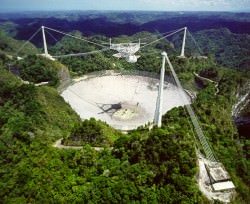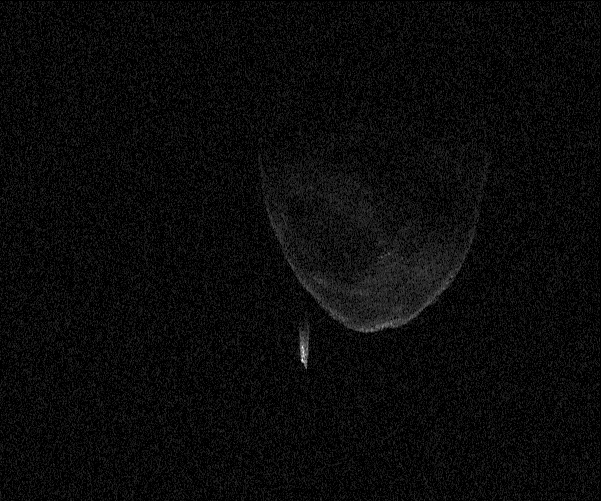On the last day of May 2013 asteroid 1998 QE2 passed relatively closely by our planet, coming within 6 million kilometers… about 15 times the distance to the Moon. While there was never any chance of an impact by the 3 km-wide asteroid and its surprise 750 meter satellite, astronomers didn’t miss out on the chance to observe the visiting duo as they soared past as it was a prime opportunity to learn more about two unfamiliar members of the Solar System.
By bouncing radar waves off 1998 QE2 from the giant dish at the Arecibo Observatory in Puerto Rico, researchers were able to construct visible images of the asteroid and its ocean-liner-sized moon, as well as obtain spectrum data from NASA’s infrared telescope in Hawaii. What they discovered was quite surprising: QE2 is nothing like any asteroid ever seen near Earth.

Both Arecibo Observatory and NASA’s Goldstone Deep Space Communications Complex in California are unique among telescopes on Earth for their ability to resolve features on asteroids when optical telescopes on the ground merely see them as simple points of light. Sensitive radio receivers collect radio signals reflected from the asteroids, and computers turn the radio echoes into images that show features such as craters and, in 1998 QE2’s case, a small orbiting moon.
QE2’s moon appears brighter than the asteroid as it is rotating more slowly; thus its Doppler echoes compress along the Doppler axis of the image and appear stronger.
Of the asteroids that come close to Earth approximately one out of six have moons. Dr. Patrick Taylor, a USRA research astronomer at Arecibo, remarked that “QE2’s moon is roughly one-quarter the size of the main asteroid,” which itself is a lumpy, battered world.
Dr. Taylor also noted that our own Moon is a quarter the size of Earth.
QE2’s moon will help scientists determine the mass of the main asteroid and what minerals make up the asteroid-moon system. “Being able to determine its mass from the moon helps us understand better the asteroid’s material,” said Dr. Ellen Howell, a USRA research astronomer at Arecibo Observatory who took both radar images of the asteroid at Arecibo and optical and infrared images using the Infrared Telescope Facility in Hawaii. While the optical images do not show detail of the asteroid’s surface, like the radar images do, instead they allow for measurements of what it is made of.
“What makes this asteroid so interesting, aside from being an excellent target for radar imaging,” Howell said, “is the color and small moon.”

“Asteroid QE2 is dark, red, and primitive – that is, it hasn’t been heated or melted as much as other asteroids,” continued Howell. “QE2 is nothing like any asteroid we’ve visited with a spacecraft, or plan to, or that we have meteorites from. It’s an entirely new beast in the menagerie of asteroids near Earth.”
Spectrum of 1998 QE2 taken May 30 at the NASA Infrared Telescope Facility (IRTF) on Mauna Kea was “red sloped and linear,” indicating a primitive composition not matching any meteorites currently in their collection.
For more radar images of 1998 QE2, visit the Arecibo planetary radar page here.
Source: Universities Space Research Association press release.


And the spectra says this asteroid is coated with or made out of…………?
Indeed. Gimme some MEAT to chew on.
Iron oxides maybe?
Yup iron oxides that have not been heated to extremes.
Unlikely to find iron oxides on something that hasn’t been altered, thermally or via water. Primitive bodies wouldn’t necessary look red to your eyes, but appear strongly in the red part of their spectra.
Also, the spectrum doesn’t show an iron band at 0.4 microns, so, good chance there’s no aqueously processed iron.
The red colour of the asteroid may be due to it being coated with tholins – formed by solar ultraviolet irradiation of simple organic compounds such as methane or ethane.
I thought tolins were mostly found in the outer solar system… ?
Affirmative. There is speculation that asteroid 1998 QE_2 may be an extinct comet.
Just that. Speculation. 🙂
Love?…lol …
Where’s my t-scope ‘old man’…lol.
Good question! You might start the process by looking at these links?
http://www.telescopes.com/?source=googleaw&kwid=buying%20a%20telescope&tid=phrase&gclid=CKnzoOSH7rcCFaU5Qgod5XoAnQ
http://www.chabotspace.org/forms/telescope-makers-workshop.htm?gclid=CPyvuveH7rcCFcqDQgodwGQAqA
http://www.telescopemirrorblanks.com/mirror_blanks.html
http://www.mdpub.com/scopeworks/
Thanks buddy. I will check ’em all out. But I wanted a tscope from you. Why? You know the business. Your knowledge knowing all the ‘best’ parts made out there is the key reason. . You can take the best parts from all companies and assemble the best tscope out there. A do it yourself project from a man who knows the very best parts to use to make a tscope better than a commercial one. Sort of like a customized thing but ONLY using the best parts from the very best companies. Betchya your tscopes would kick ass over them all ;-).
I think you have vastly overestimated my abilities. Take a look at that last link… now THERE’s a guy who knows his stuff! My thing is show others that they too can use their cod given talents to build a telescope! If a fool like me can do it… so can you!
Well said Aqua. (for except the ‘cod’ thing) I will begin the process with the links you have supplied me asap. I will give you a run down of what I will try to accomplish to the end product.
By the way? My ‘cod’ given talents have yet to grow me gills. I’ll try! Underwater tscope?. What a concept aqua! Your brilliant!…lol. . God Bless buddy…;-)
Universetoday exists to give us a headsup on what is happening now. This article is based on the Press Release, nothing more. The detailed results will appear in specialist journals much later. They will be peer reviewed and that standard takes a while to achieve.
Here’s a thought, the Sumerian’s described the 7th planet Nibiru as red, before it exploded into the asteroid belt.
Notice especially in the movie that the surface appears to have maria or dark “seas” like the moon rotating. Very interesting!
Since this is a radar image, the dark areas wouldn’t necessarily be dark to your eyes. They simply don’t reflect the radar waves particularly well.
sigh.
Nibiru doesn’t exist today. Where do think asteroids come from? Where do you think the rings of Saturn and Jupiter come from? The exploded planet that is now the asteroid belt. Look at the moons throughout the solar, their leading edges have 7 to 1 and as much as 9 to 1 more asteroid craters in the leading edge than their trailing edges, Like a car going through a hail storm the front or leading edges receives more damage. The small light gravel and frozen atmosphere material quickly became part of the giant gas planets, while the rest eventual formed as the asteroid belt.
Nibriu is a fictional Start Trek planet.
Not at all Olaf2. Nibiru is part of the ancient writings of the Sumerians.
Have you seen Into Darkness yet?
Contrary to the depiction in many cheap sci-fi movies, the asteroid belt is mostly empty and the asteroids are spread out over a vast area of space. The total mass of the asteroid belt is estimated to be 2.8×10^21 to 3.2×10^21 kilograms – which is just 4% of the mass of the Moon!
The 2 largest “asteroids” are not asteroids at all, but former moons. Take a look at their shape, very moon like. Moons unlike planets have a very smooth surface, with little topography changes. Yes you’re right that % number has been what has discounted the asteroid belt from discussed as a former planet, including the the asteroids on Jupiter’s orbit, but if not a planet the question is what?The asteroid belt is also in the location predicted by Bode’s Law. My answer of the missing mass, is a large number of asteroids have collided with the other planets, been consumed by the sun, and are now bits of the large planet rings.
Velikovsky was never given any credence when he was alive. I see no reason to change the consensus opinion.
I’m not suggesting his work, though he was quite a prolific author. My point is the asteroid is a remnant of a planet. That cannot be considered a stretch, many astronomists have said the same. including the German astronomer Oblers in 1807 who said;
“Could it be that Ceres and Pallas are just a pair of fragments…of a once greater planet which at one time occupied its proper place between Mars and Jupiter?”
While it is interesting to speculate on what exactly the ancient Sumerian culture saw and recorded in the sky, it is today nearly impossible to confirm their observations. Some of their ‘gods’ were depicted as being half man and half fish! Other ancient civilizations depicted dragons and other strange creatures as gods. The Norse, Egyptian, Chinese and ‘New World’ civilizations are filled with these descriptions. This has lead to endless speculation from less than credible sources that mankind was visited by extraterrestrials who arrived, in all their supposed advanced wisdom, to either help us preserve the knowledge of even more ancient earthly civilizations, or attempt to destroy mankind. At best, these fabrications make for interesting conjecture and fictional stories. At worst, those stories are misleading and muddy up the waters of history. Bottom line is that until we find _proof_ with undeniable evidence, they are simply remnants of mythological invention.
They are not “former moons”, they are protoplanets; the almost sphereical shape of Ceres is due to hydrostatic equilibrium.
As for the missing mass, 99.9% of the asteroid belt’s original mass was lost in the first 100 million years of the Solar System’s history, primarily because of gravitational perturbations from Jupiter as it migrated inwards during the formation of the Solar System..
I think what it meant by “red” was that it was red in Infrared. Because it said there was no signifigant heating or melting, keeping it pretty cool in Infrared. And, we used Infrared telescopes, not visible light, so how could we see the actual surface colors? There was no description of the asteroids composition. It even said that. How could Iron Oxide be made with no oxygen, because there is no atmosphere. And no liquid water to first get the iron wet. And Tholin can be made with Methane, right? Well, if methane is abundant on this asteroid, than the red of the Tholin would be “absorbed” by the Methane, just like on Uranus and Neptune.
See: Fourier transform infrared spectroscopy.
The article states: “Asteroid QE2 is dark, red, and primitive – that is, it hasn’t been heated or melted as much as other asteroids,” [said Dr. Ellen] Howell.
As for where would the tholins come from, the Wikipedia “Tholin” article (see above link) states: “The surfaces of comets, centaurs, and many icy moons in the outer solar system are rich in deposits of Triton, Titan and ice tholins. […]. Tholins may also have been detected in the protoplanetary disks of young stars; see HR 4796A. Some researchers have speculated that Earth may have been seeded by organic compounds early in its development by tholin-rich comets, […].”
Red in this case just means “redder than sunlight in the infrared”.
Hi Jason! Hello from Arecibo. The credit on the first animation is Arecibo Observatory/NAIC/Sean Marshall. Thanks!
Ok, thanks! Fixed.
Insufficient data to make a positive assertion. 😉